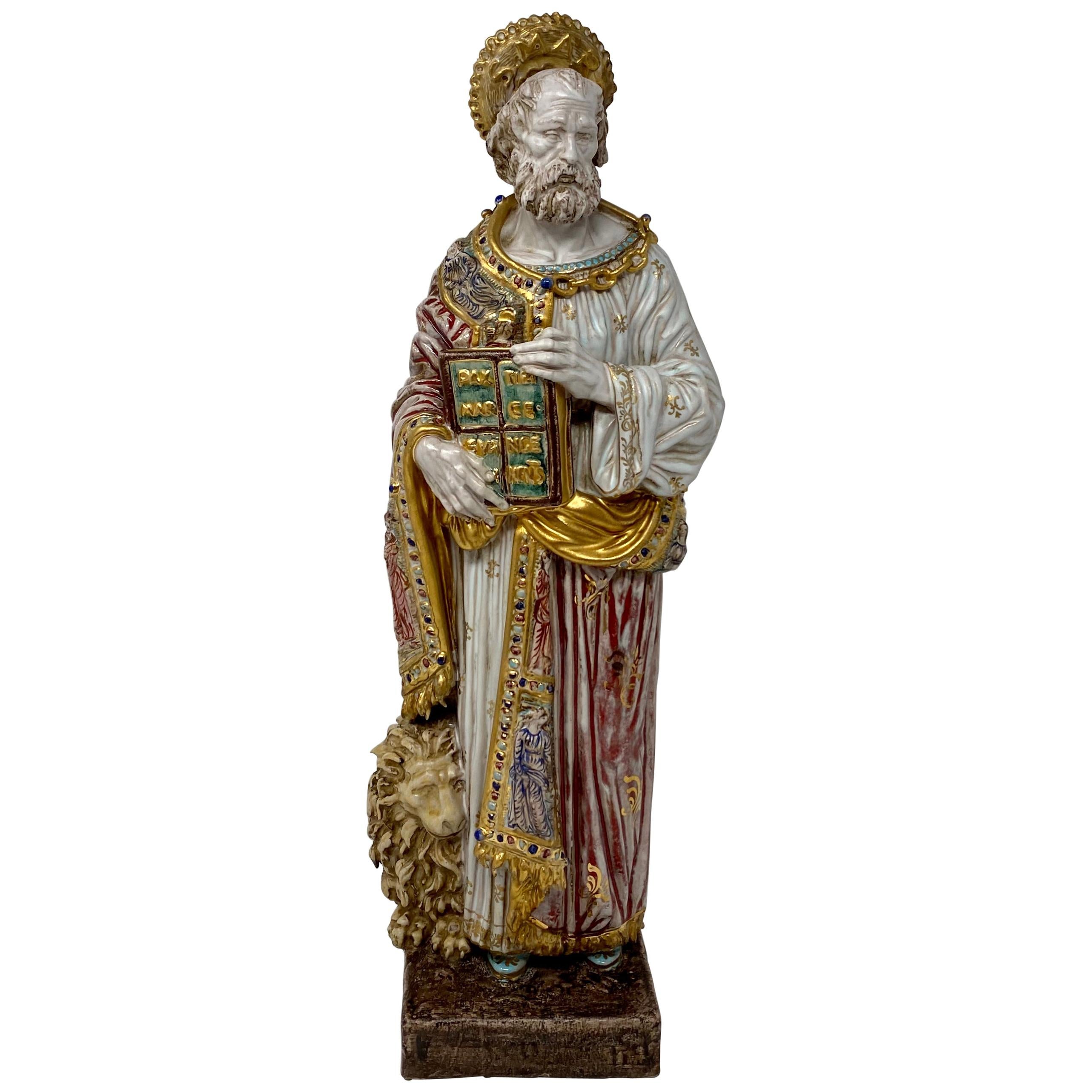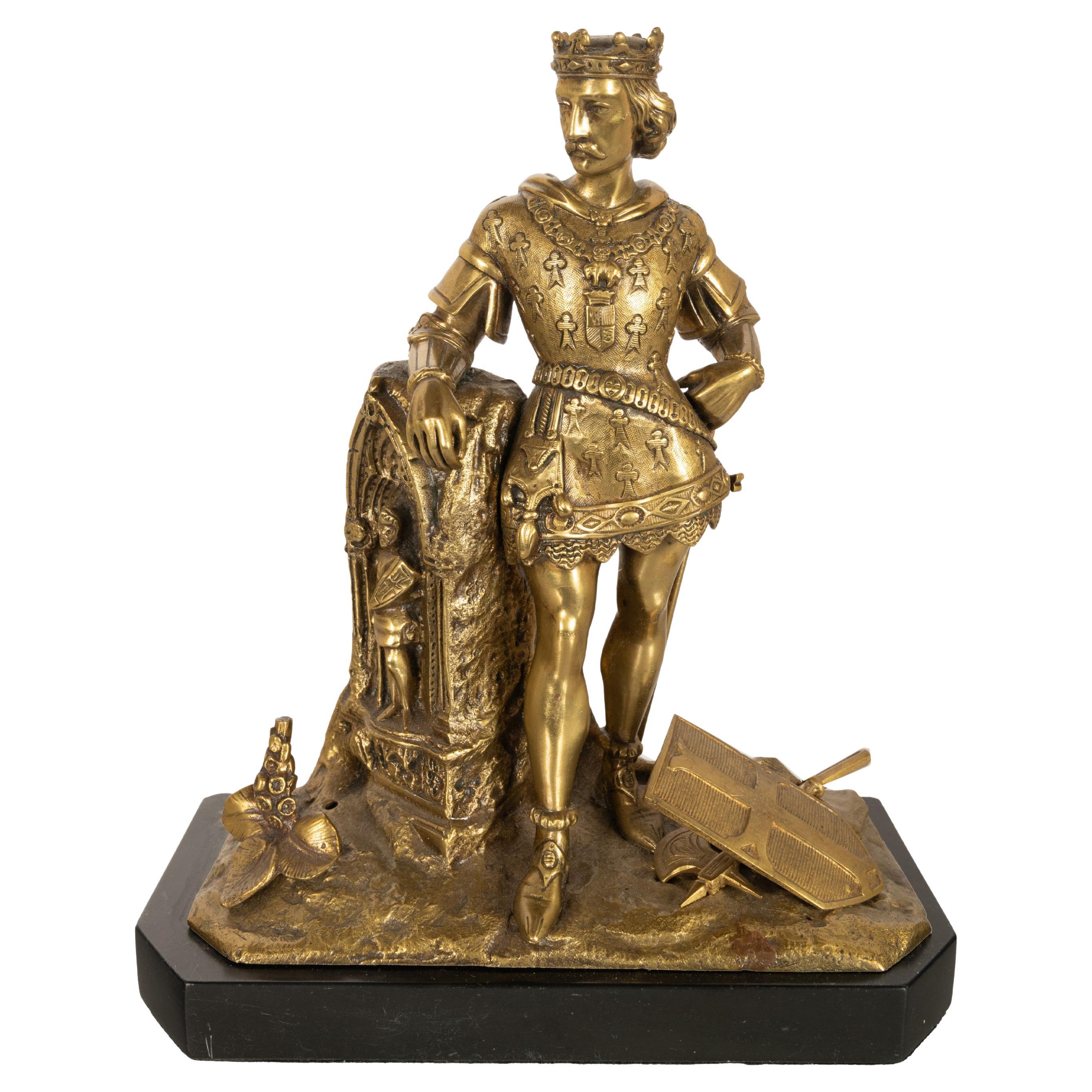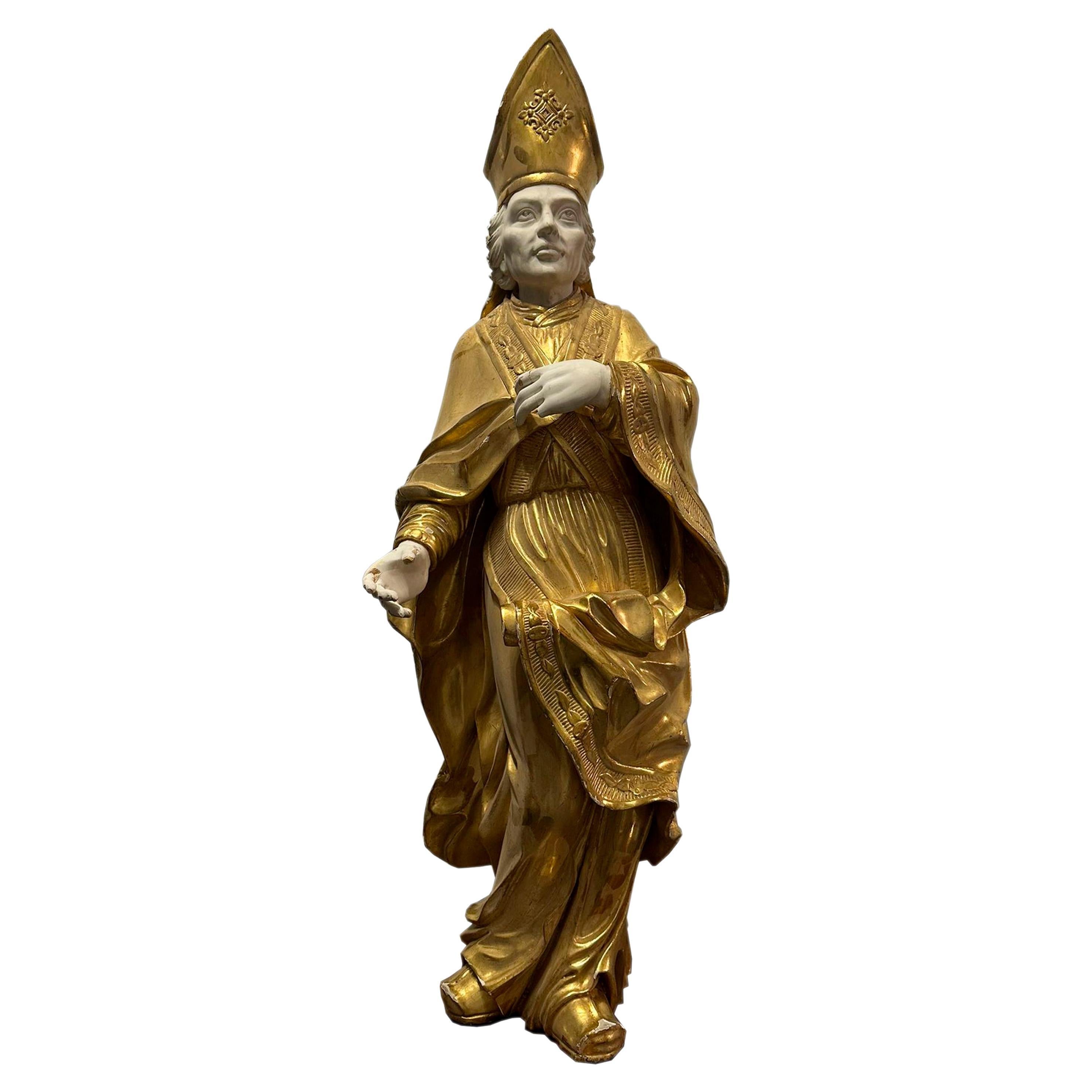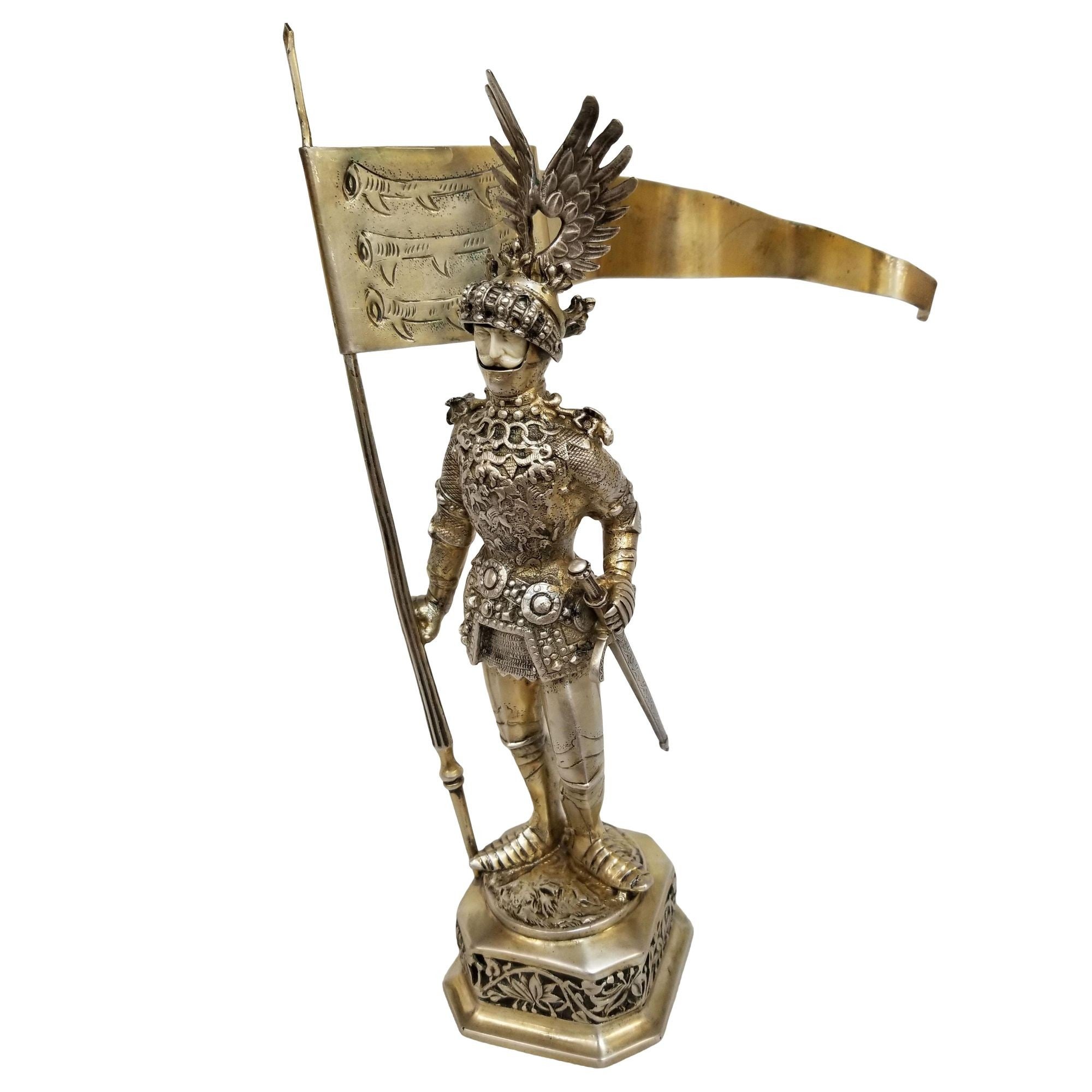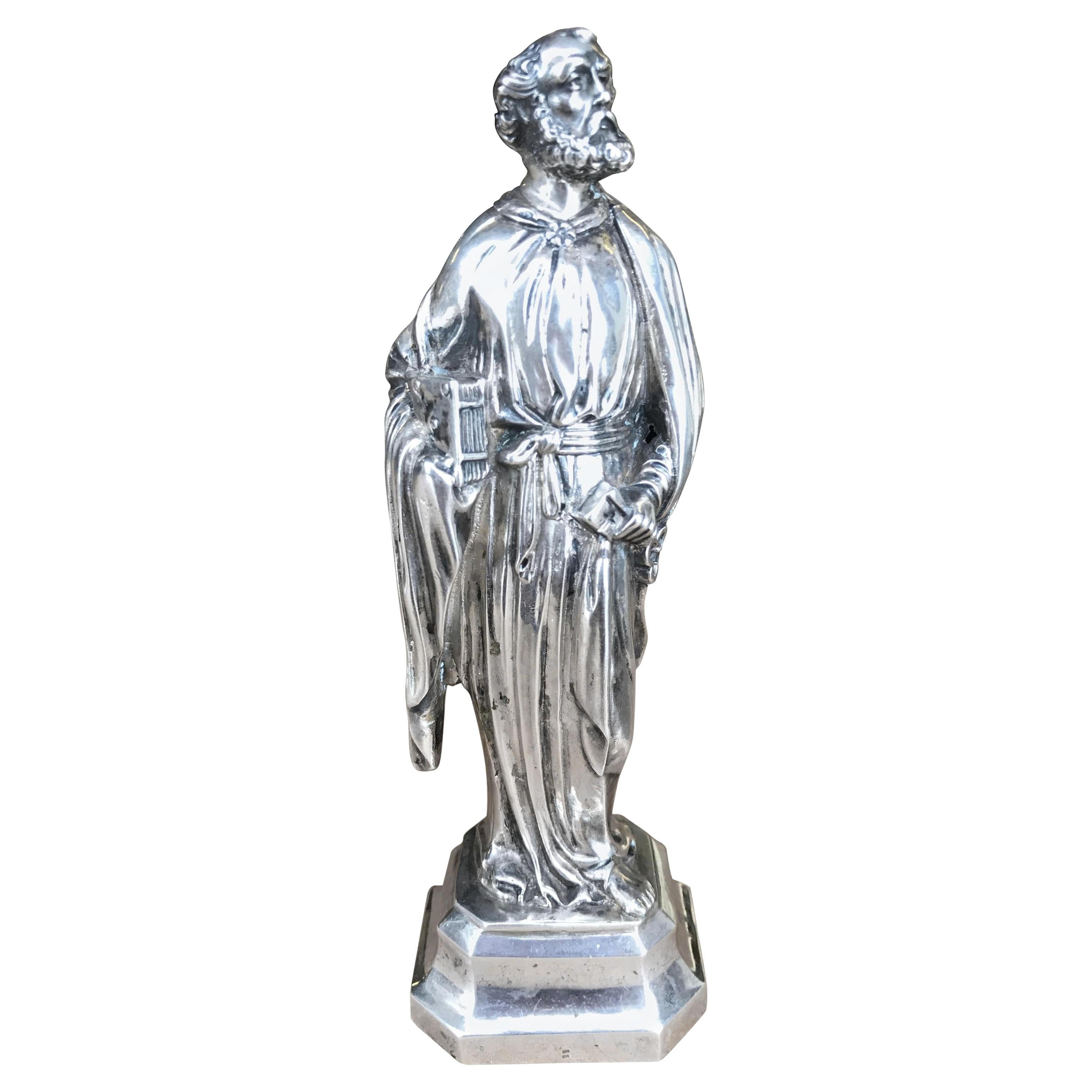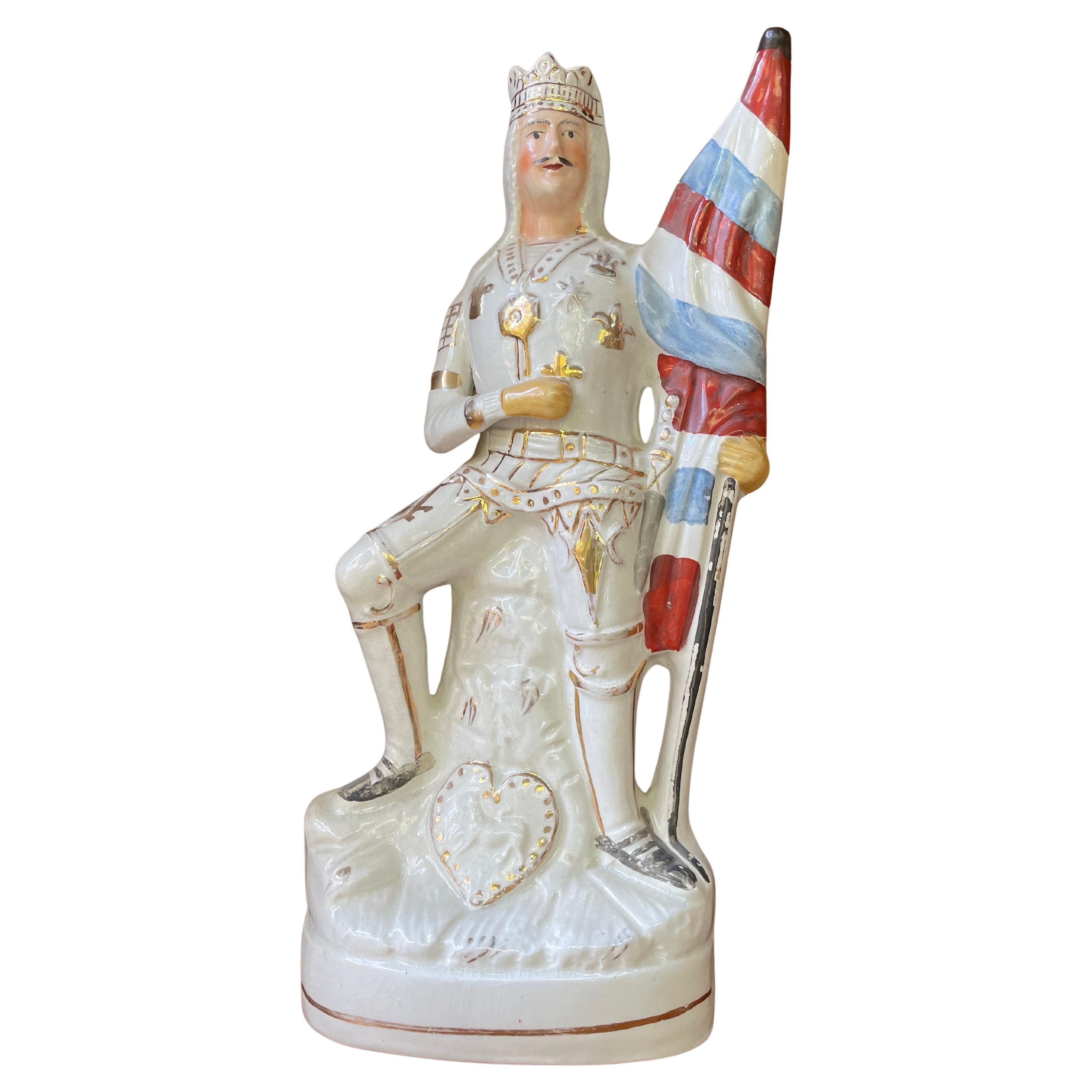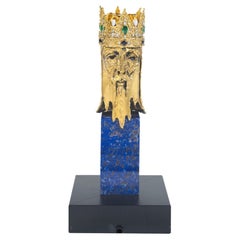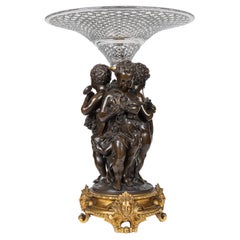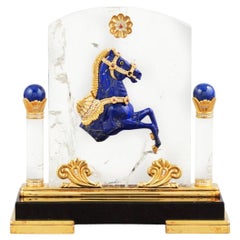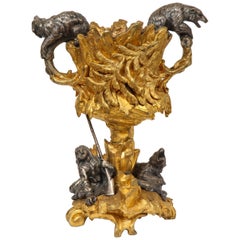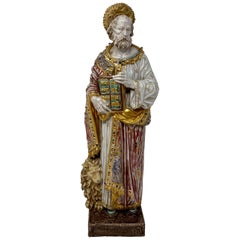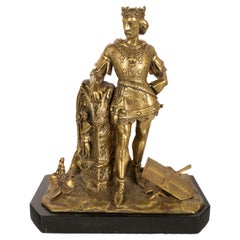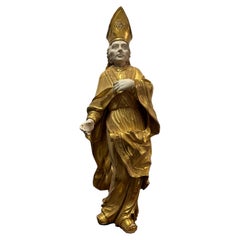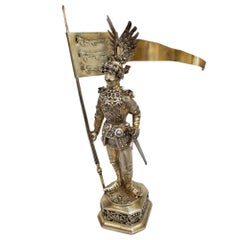Items Similar to Enamel Gold and Rock Crystal Figure of Emperor Maximilian I by Reinhold Vasters
Video Loading
Want more images or videos?
Request additional images or videos from the seller
1 of 12
Enamel Gold and Rock Crystal Figure of Emperor Maximilian I by Reinhold Vasters
Price Upon Request
Price Upon Request
Price Upon Request
Price Upon Request
Price Upon Request
Price Upon Request
Price Upon Request
Price Upon Request
Price Upon Request
Price Upon Request
Shipping
Retrieving quote...The 1stDibs Promise:
Authenticity Guarantee,
Money-Back Guarantee,
24-Hour Cancellation
About the Item
A rare enamel, gold and rock crystal figure of Emperor Maximilian I by Reinhold Vasters, Aachen,
In the Renaissance style, circa 1870.
The gold figure in bright enameled priestly clothing, wearing the Habsburg imperial crown, with orb and scepter on his enameled hands, standing on a rock crystal base.
The rock crystal base marked: "Maximilianus I. MCCCCXCIII" [1493]
Apparently unmarked
Measures: Height 9.5 in high
A true museum masterpiece. A rare opportunity to own this wonderful object.
Literature:
Miriam Krautwurst, Reinholt Vasters: Ein nederrheinischer Goldschmied des 19. Jahrhunderts in der Tradition alter Meister. Sein Zeichnungskonvolut im Victoria and Albert Museum, Trier (University doctoral thesis), 2003
About Reinhold Vasters:
Vasters was the son of a locksmith, and in 1853 entered his maker’s mark as a goldsmith in Aachen, near his birthplace. The same year he was appointed restorer to the Aachen Cathedral treasury, and became known as a maker of church plate in gothic style. However, it was his work in the Renaissance style which brought him prosperity, and later notoriety. In association with the Vienna-born Paris dealer Frédéric Spitzer, he enhanced incomplete or damaged early works of art, or created them whole-cloth based on early examples. Spitzer sold these on to the major collectors of the 1870s and 1880s, particularly members of the Rothschild family. After Spitzer’s death in 1890, his collection (including remaining stock) was luxuriously published then dispersed by auction, with many pieces finding their way to American collectors such as J.P. Morgan, Benjamin Altman, and Henry Walters.
Long accepted as antiques, Vasters’ works have been recently identified through a group of drawings preserved at the Victoria and Albert Museum. Sold at Vasters posthumous sale in Aachen in 1909, they were given to the V&A in 1919. From these, many Vasters’creations, probably in association with Spitzer and the goldsmith Alfred André, have been identified, including thirty pieces in the Metropolitan Museum (Yvonne Hackenbroch, “Reinhold Vasters, Goldsmith” Metropolitan Museum of Art Journal 19/20 (1986), p. 164).
From his beginnings at the Cathedral Treasury, repairing and reworking genuine ancient items was one of Vasters’ specialties. Contemporary accounts credited Spitzer with persuading clergy to sell him old liturgical items cheaply, because of damage and wear, while offering to replace them with new creations in “historical” styles that would better suit contemporary religious practice (ibid. p. 169). When Vasters loaned almost 500 pieces from his own collection to a Kunsthistorische Ausstellung in Düsseldorf in 1902, the group included fractured rock crystal vessels and orphan lids and pedestals. These suggest less a finished “collection” than the contents of a workshop, the antique raw material around which to create a finished complete item for Spitzer's clientele. Ms. Hackenbroch’s study of Vasters’ work distinguishes between “gold-mounted rock crystals of sixteenth and seventeenth-century origin” and those of nineteenth-century origin, and this divide is echoed in the character of the V&A drawings; there are fewer whole designs than there are small, exquisitely rendered details, suggesting enhancements to existing forms.
The drawings associated with the offered lot are a case in point. First published by Miriam Krautwurst in her 2003 doctoral thesis, these beautifully colored designs show the attributes held by each figure, and designs for the two patterns of wings. The figures, whose origins will be considered in the next section, were the sort of fragments with which Spitzer and Vasters excelled. Their poses required pedestals; they were supplied in richly colored lapis lazuli, enhanced by enameled gold moldings. Their open and outstretched hands required objects; rather than the religious emblems that they probably originally held, a secular program was developed – perhaps to better appeal to non-Catholic or Jewish collectors.
- Dimensions:Height: 9 in (22.86 cm)Width: 3 in (7.62 cm)Depth: 2 in (5.08 cm)
- Style:Renaissance (In the Style Of)
- Materials and Techniques:
- Place of Origin:
- Period:
- Date of Manufacture:circa 1870
- Condition:
- Seller Location:Queens, NY
- Reference Number:1stDibs: f179821710278904663fs
About the Seller
5.0
Vetted Professional Seller
Every seller passes strict standards for authenticity and reliability
Established in 1980
1stDibs seller since 2016
63 sales on 1stDibs
Typical response time: 5 hours
- ShippingRetrieving quote...Shipping from: Queens, NY
- Return Policy
Authenticity Guarantee
In the unlikely event there’s an issue with an item’s authenticity, contact us within 1 year for a full refund. DetailsMoney-Back Guarantee
If your item is not as described, is damaged in transit, or does not arrive, contact us within 7 days for a full refund. Details24-Hour Cancellation
You have a 24-hour grace period in which to reconsider your purchase, with no questions asked.Vetted Professional Sellers
Our world-class sellers must adhere to strict standards for service and quality, maintaining the integrity of our listings.Price-Match Guarantee
If you find that a seller listed the same item for a lower price elsewhere, we’ll match it.Trusted Global Delivery
Our best-in-class carrier network provides specialized shipping options worldwide, including custom delivery.More From This Seller
View AllAn 18K Gold and Gem Set Bust of a King, by George Weil London
Located in Queens, NY
An 18K Gold and Gem Set Bust of a King, by George Weil London, circa 1970
This magnificent 18K gold and gem-set bust of a king, crafted by George Weil in London, stands as an embodi...
Category
20th Century British Collectible Jewelry
Materials
Lapis Lazuli, Gold
Mathurin Moreau, A Monumental French Bronze and Crystal Figural Centerpiece
By Mathurin Moreau
Located in Queens, NY
Mathurin Moreau (French, 1822-1912)
A Monumental French Bronze and Crystal Figural Centerpiece
Introducing an extraordinary and monumental Fre...
Category
Antique 19th Century French Napoleon III Centerpieces
Materials
Crystal, Bronze
Mellerio Paris, A French Gold, Diamond, Silver-Gilt, Rock-Crystal, & Lapis Horse
By Mellerio
Located in Queens, NY
Mellerio Paris, A French Gold, Diamond, Silver-Gilt, Rock-Crystal, Obsidian & Lapis Horse
An extremely rare and unique, one of a kind French gold, diamonds, Silver-gilt rock-crystal, obsidian and lapis lazuli jeweled sculpture "Bucéphale, Chevaux de légende", "Bucephalus, A Legendary Horse" by Mellerio, Paris, circa 1998.
Sitting on black obsidian base, the solid rock crystal slab is finely applied with a lapis lazuli half-horse with harness mounted in 18k gold and brilliant cut diamonds, between two crystal and lapis lazuli columns adorned with gold and diamonds, insert with 7 ruby cabochons and 1 emerald cabochon, the obsidian base with a plaque engraved: CHEVAUX DE LEGENDE / MELLERIO DITS MELLER / PARIS / 5029 DIV
Bucephalus (c355-326 BC) is among the most famous horses in history, and it was said that this he could not be tamed. The young Alexander the Great, of course, tamed him – and went on to ride his beloved equine companion for many years and into many battles.
The piece is in excellent condition and comes with a custom made wood case made for transport. It's very elegant and has French hallmarks throughout. A truly magnificent piece.
Measures 10" high x 9" wide x 4" deep
Founded in France in 1613 by the descendants of Italian immigrants from the Vigezzo Valley in the north of Italy, Mellerio is one of the oldest jewellery houses in Europe. The family business soon attracted the attention of the Royal Court and Marie Antoinette herself reportedly purchased a precious bracelet featuring 7 cameos surrounded by rubies in 1780. Later on, in the 19th century, Mellerio became the official supplier of the French Royal family and the Court of Netherland.
Mellerio creates many jewellery items, all set with rare gems such as peridots, amethysts, aquamarines, citrines and topaz, applying for a patent, the flexible stem, a very supple and light jewellery mechanism. Mellerio remains also well known for their spectacular series of Art Nouveau jewels, created at the beginning of the 20th century, as well as for the creation of trophies rewarding some of the greatest footfall and tennis players of history. In 1993, the jewellery house launched their first watch collection.
Today, Mellerio has stores in Paris, Japan and Hong Kong.
July 14, 1789: this date is known throughout the world as the beginning of the French Revolution. According to a ledger belonging to House of Mellerio, this was also the day that the jeweler sold a golden key to the Comte de Coutance for 10 livres. This ledger, as well as inventories dating as far back as 1768, are the jeweler’s oldest archives. These archives have continued to grow over the years, as the House, established on rue de la Paix in Paris, still lives on today, still in the hands of the same family from Craveggia, in the North of Italy.
The tumultuous history of the Mellerio family in France probably goes as far back as the Italian wars of the Renaissance, but the first official document proving their commercial activity in Paris dates back to 1613. This document is the famous royal warrant awarded by Marie de Medici to a number of Italian families established along the rue des Lombards, including the Mellerios, allowing them to sell “small jewelery items”, therefore granting them a small exception to the traditional monopoly enjoyed by Parisian jewelers. At that time, powerful corporations regulated the operations and customs of Parisian business, but thanks to this exceptional warrant, the Mellerios managed to escape the confines of this framework. Today, this wax-sealed document is kept at the city hall of Craveggia.
From 1613 to the Revolution, the Mellerios lived between France and Italy. The corporations tried many times to put an end to their trade privileges, but all in vain, as a dynasty of sovereigns renewed the warrant. Always marrying and often retiring in Craveggia, the Mellerios continued to maintain their jewelry business in Paris. At first, they did this without a shop. Wearing backpacks (wooden boxes divided into small compartments where jewels were kept), they would tour town fairs around Paris and royal castles.
This is how Jean-Baptiste Mellerio (1765-1850) is said to have sold a bracelet set with rubies and Antique cameos to Marie-Antoinette, which still exists today. Many elements seem to prove the veracity of this anecdote. The queen was particularly fond of cameos, which cover the entire background of her famous jewelry cabinet, and ruby was her favorite stone after diamond. The famous bracelet, reacquired a few years ago by the House of Mellerio, is indeed an 18th century jewel, set with antique cameos representing the profiles of Roman emperors. Two branches of the family were operating in Paris during this time, under the reign of Louis XVI: that of Jean-François (1746-1828), the paternal ancestor of the current Mellerios, and that of Jean-Baptiste (1765-1850).
The French Revolution forced them to return to Italy. However, both Jean-Baptiste and François Mellerio (1772-1843), who was the son of Jean-François, were eventually able to return to Paris after the founding of the Consulate. Jean-Baptiste opened a shop at the Iron Crown of rue Vivienne, and François opened his at the Palais des Tuileries, rue du Coq Saint-Honoré. His well-organized order books give an idea of his high-ranking clientele during the “Old Regime”, among which were the Comte and Comtesse Octave de Segur, the Marquise (later Duchess) de Tourzel, former governess of the royal children, and her daughter, the Comtesse de Bearn, the Craufurds -who organized the flight to Varennes, the Duc and Duchess de Gramont, the Comtesse de Boigne, and Madame de Souza, Talleyrand’s mistress.
We also see the names of the imperial family: Empress Josephine, the Queen of Holland, Princess Elisa, Caroline and Pauline. At that time, the House of Mellerio specialized, among other things, in the trade of antique cameos, a newly fashionable genre of jewel that captured the imagination of all the princesses and noble women of the time.
The years of the Restauration and July Monarchy were among the most glorious. The Bourbons were back on the throne, and the clientele of the House of Mellerio had regained its former wealth. Mellerio supplied Louis-Philippe, Duke of Orléans, as well as his mother, wife and sister, with sumptuous jewels, including a set of emeralds made piece by piece, while the Duke of Bourbon, last prince of the House of Condé, offered diamonds to his mistress, the scheming Baronne de Feucheres, and Monsieur de LaFayette also bought cameos for one of his granddaughters. For the first time, Mellerio ventured into the world of arts in 1815, when Carlotta Grisi, a famous dancer who created Giselle, as well as an actress named Rachel, bought jewels at the Mellerio store on rue de la Paix.
1848 marked a new turning point. France once again became a Republic. François Mellerio handed the company over to his son, Jean, and the latter decided to travel to Spain to build a new clientele. He later became one of the jewelers of the royal family, and met Eugénie de Montijo, who remained a faithful client when she became empress of the French people. The Imperial years were lavish. During the Second Empire, Paris was a pageant of crinoline dresses designed by Worth, while jewels by Mellerio, Worth’s neighbour on the rue de la Paix, adorned the noble women of the Tuileries court.
The Empress bought pearls. Mathilde Bonaparte...
Category
20th Century French Mounted Objects
Materials
Lapis Lazuli, Rock Crystal, Gold, Silver
Important Ormolu and Silvered Bronze Figural Wine Cooler, Possibly Russian, 1860
By Pavel Sazikov
Located in Queens, NY
Important ormolu and silvered bronze figural wine cooler, possibly Russian, 1860
Gilt and silvered bronze wine cooler. Modeled with two Russian polar bears at the handles and with a young gunmen holding a rifle seated with a sea otter...
Category
Antique 19th Century Russian Wine Coolers
Materials
Bronze
A Rare 1859 Elkington Silvered Bronze Victorian "Trophy" Centerpiece
By Elkington Mason & Co.
Located in Queens, NY
A Rare and Historic 1859 Elkington Silvered Bronze Victorian Centerpiece with Cut-Glass Bowl.
Presenting a magnificent Victorian silvered bronze centerpiece of unmatched rarity and importance, crafted by the renowned Elkington Mason & Co., Birmingham, in 1859. This exceptional work, complete with its original cut-glass bowl, epitomizes 19th-century British craftsmanship and artistry. Hallmarked to the base, this centerpiece showcases intricate sculptural details, embodying a high level of technical prowess and aesthetic refinement characteristic of Elkington's celebrated works.
The centerpiece's striking design features three meticulously rendered figures—a young hunter, a friar, and a fishmonger—each embodying elements of Victorian life and industry. At their feet, a loyal spaniel and various game highlight the naturalistic approach to the composition, enhanced by the masterful chasing and dynamic form. This sculptural ensemble rests on an elaborately decorated base, exuding both grandeur and narrative depth.
Adding profound historical value are two engraved plaques. The first, dated “January 28, 1859,” reads: “Presented to William Johnson Esq. as a token of respect & esteem by the workpeople in the employ of Messrs Richard Johnson & Brother, Manchester.” The second, an inscription from 1941, states: “Worshipful Company of Tin Plate Workers, Alias Wire Workers of the City of London, Presented by Arthur Laurence Johnson M.A., Grandson of William Johnson, both Wire Workers, with his Daughter Eleanor Morton Johnson, a Freeman of the Company, to commemorate his Mastership 1941-42.”
These inscriptions chart a rich lineage, connecting the Johnson family to pivotal moments in industrial history. William Johnson, alongside his brother Richard, assumed leadership of a wire-drawing firm in 1838, which would later become Richard Johnson & Nephew Ltd. Their contributions included providing galvanized armored wire for the historic 1857 transatlantic telegraph cable...
Category
Antique 19th Century British Victorian Centerpieces
Materials
Metal, Bronze
Monumental Silvered and Gilt-Bronze Glass Centerpiece of "Poseidon"
Located in Queens, NY
A Monumental French Silvered and Gilt-Bronze and Glass Centerpiece of "Poseidon", Paris, circa 1895.
A very good quality centerpiece depicting "Poseidon and his seahorses", of mon...
Category
Early 20th Century French Classical Greek Centerpieces
Materials
Bronze
$37,500 Sale Price
50% Off
You May Also Like
Original Porcelain Figure of Mark, circa 1930s-1950s
Located in New Orleans, LA
Original porcelain figure with mark of professor E. Patterino, maker, circa 1930s-1950s.
Category
Early 20th Century Italian Porcelain
Materials
Porcelain
Antique French Gilt Bronze Statue Medieval King Louis VII Knight Templar 1880
Located in Portland, OR
A fine Antique 19th century cast gilt bronze statue of the medieval French King Louis VII of France, circa 1880.
King Louis VII (1120–1180) was the King of France from 1137 unt...
Category
Antique 1880s French Medieval Figurative Sculptures
Materials
Marble, Bronze
Saint Nicholas of Bari Handcarved Sculpture with Gold Leaf, France, 19th Century
Located in Madrid, ES
French carving depicting Saint Nicholas of Bari. It is handcrafted in carved wood and polychromed in gold leaf. France, 19th century.
Category
Antique 19th Century French French Provincial Figurative Sculptures
Materials
Wood
1890 Sterling Silver King Arthur Knight by B. Neresheimer & Söhne Hanau
By B. Neresheimer & Sohne
Located in Van Nuys, CA
This antique sterling silver knight sculpture from the 19th century is based on the statue found at the Tomb of Maximilian I: King Arthur completed in 1513. Dressed in full medieval ...
Category
Antique 19th Century German Medieval Figurative Sculptures
Materials
Silver
$4,842 Sale Price
35% Off
19th Century German Silver Ecclesiastical Figure of Sankt Peter
Located in West Palm Beach, FL
Antique loth silver ecclesiastical figure of Sankt Peter, holding a book and keys standing 6.75" high, Hallmarked with a blank elliptical mark, "N" (Nurnberg?), topiary style mark...
Category
Antique 19th Century German Religious Items
Materials
Silver
$1,760 Sale Price
20% Off
King Richard the Lionheart Porcelain Staffordshire Pottery Statue Figurine
By Staffordshire
Located in Hyattsville, MD
A Staffordshire figure of King Richard the Lionheart, 19th Century, modelled standing with a flag, in his armour and crown featuring gilded decorations, on an oval gilt-line plinth b...
Category
Early 20th Century British Late Victorian Figurative Sculptures
Materials
Porcelain
More Ways To Browse
Room Divider Gold
Imperial Crown
Antique Clothing Museum
Henry V
Antique Crystal Makers Marks
1919 Clothing
Cathedral Plates
Gothic Church Items
Used Catholic Church Items
Lapis Lazuli Figure
Antique Catholic Church Items
Antique Catholic Religious Items
Maximilian Design
Antique Locksmith
Antique Furniture Locksmith
Cathedral Crown
Rothschild Plate
Used Liturgical Items
